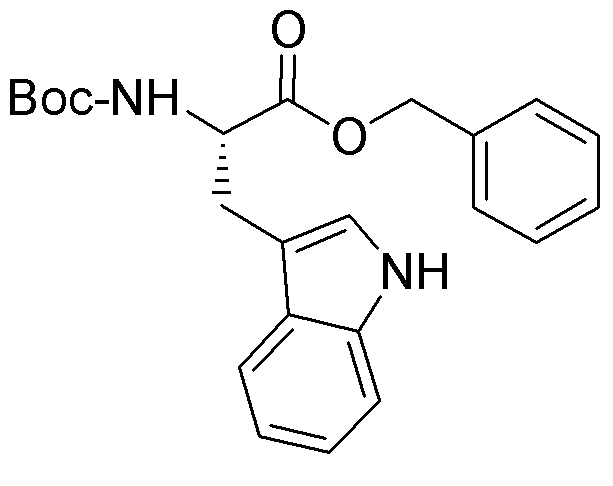Na-Boc-L-tryptophan benzyl ester is widely utilized in research focused on:
- Peptide Synthesis: This compound serves as a key building block in the synthesis of peptides, particularly those involving tryptophan. Its protective Boc group allows for selective reactions, enhancing the efficiency of peptide assembly.
- Drug Development: In pharmaceutical research, it is used to create novel compounds that can target specific biological pathways, particularly in the development of antidepressants and anxiolytics, leveraging the properties of tryptophan.
- Bioconjugation: The benzyl ester group facilitates bioconjugation processes, making it valuable in the creation of drug delivery systems and targeted therapies, especially in cancer treatment.
- Protein Engineering: Researchers utilize this compound in the modification of proteins to study their structure and function, aiding in the development of biomaterials with enhanced properties.
- Analytical Chemistry: It is employed in various analytical techniques to study tryptophan-related metabolites, providing insights into metabolic pathways and potential biomarkers for diseases.
General Information
Properties
Safety and Regulations
Applications
Na-Boc-L-tryptophan benzyl ester is widely utilized in research focused on:
- Peptide Synthesis: This compound serves as a key building block in the synthesis of peptides, particularly those involving tryptophan. Its protective Boc group allows for selective reactions, enhancing the efficiency of peptide assembly.
- Drug Development: In pharmaceutical research, it is used to create novel compounds that can target specific biological pathways, particularly in the development of antidepressants and anxiolytics, leveraging the properties of tryptophan.
- Bioconjugation: The benzyl ester group facilitates bioconjugation processes, making it valuable in the creation of drug delivery systems and targeted therapies, especially in cancer treatment.
- Protein Engineering: Researchers utilize this compound in the modification of proteins to study their structure and function, aiding in the development of biomaterials with enhanced properties.
- Analytical Chemistry: It is employed in various analytical techniques to study tryptophan-related metabolites, providing insights into metabolic pathways and potential biomarkers for diseases.
Documents
Safety Data Sheets (SDS)
The SDS provides comprehensive safety information on handling, storage, and disposal of the product.
Product Specification (PS)
The PS provides a comprehensive breakdown of the product’s properties, including chemical composition, physical state, purity, and storage requirements. It also details acceptable quality ranges and the product's intended applications.
Certificates of Analysis (COA)
Search for Certificates of Analysis (COA) by entering the products Lot Number. Lot and Batch Numbers can be found on a product’s label following the words ‘Lot’ or ‘Batch’.
*Catalog Number
*Lot Number
Certificates Of Origin (COO)
This COO confirms the country where the product was manufactured, and also details the materials and components used in it and whether it is derived from natural, synthetic, or other specific sources. This certificate may be required for customs, trade, and regulatory compliance.
*Catalog Number
*Lot Number
Safety Data Sheets (SDS)
The SDS provides comprehensive safety information on handling, storage, and disposal of the product.
DownloadProduct Specification (PS)
The PS provides a comprehensive breakdown of the product’s properties, including chemical composition, physical state, purity, and storage requirements. It also details acceptable quality ranges and the product's intended applications.
DownloadCertificates of Analysis (COA)
Search for Certificates of Analysis (COA) by entering the products Lot Number. Lot and Batch Numbers can be found on a product’s label following the words ‘Lot’ or ‘Batch’.
*Catalog Number
*Lot Number
Certificates Of Origin (COO)
This COO confirms the country where the product was manufactured, and also details the materials and components used in it and whether it is derived from natural, synthetic, or other specific sources. This certificate may be required for customs, trade, and regulatory compliance.


